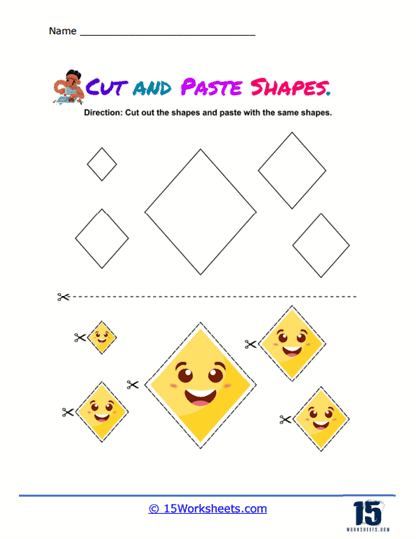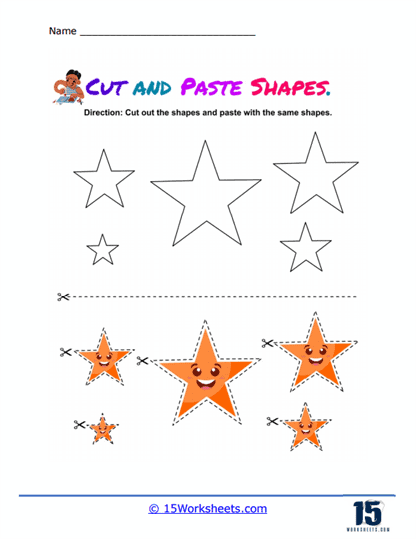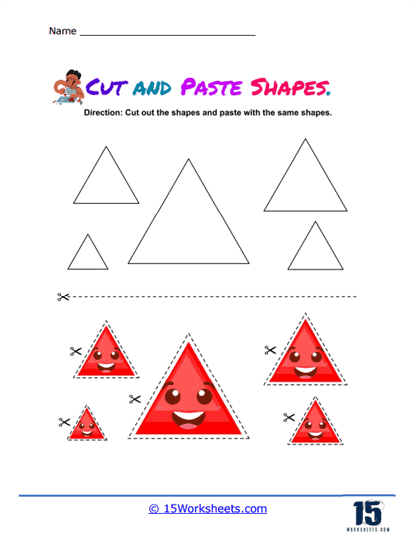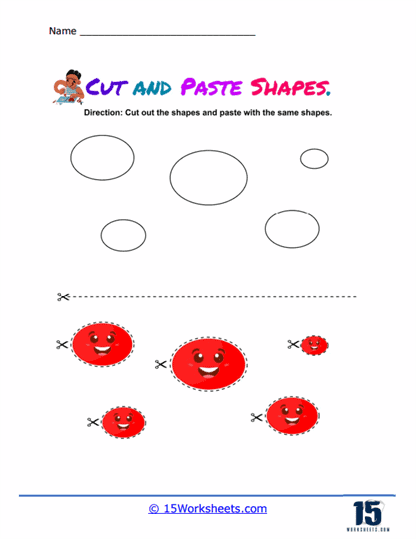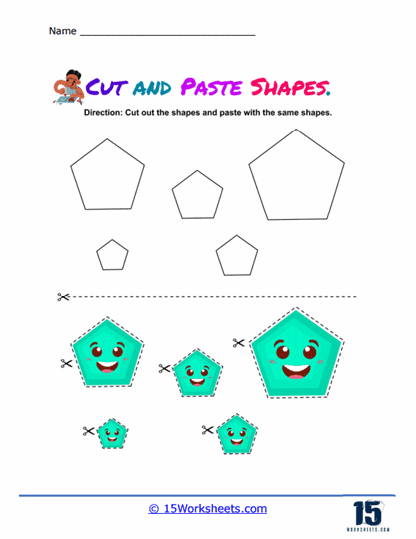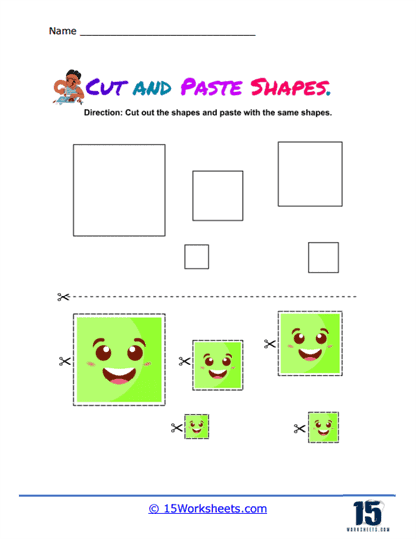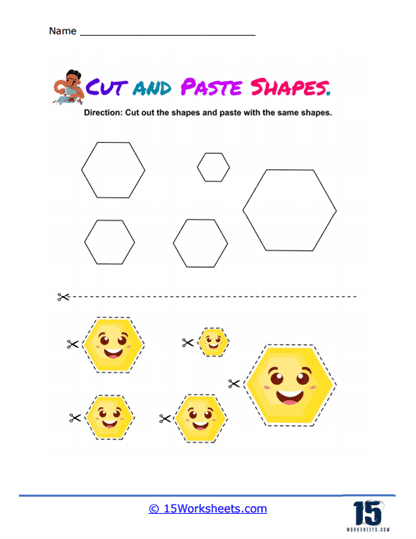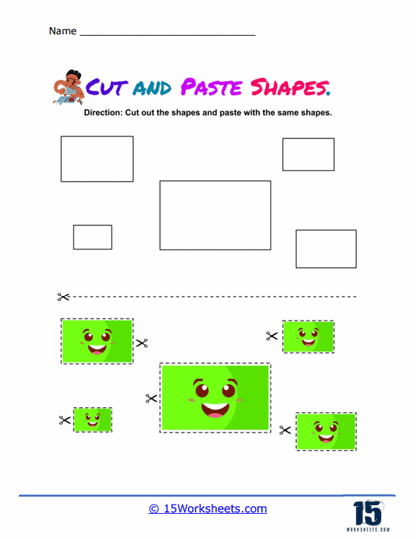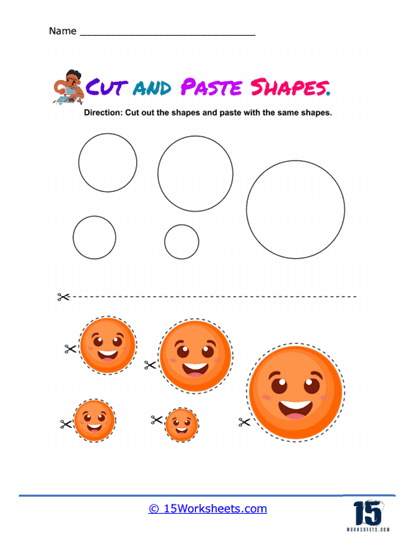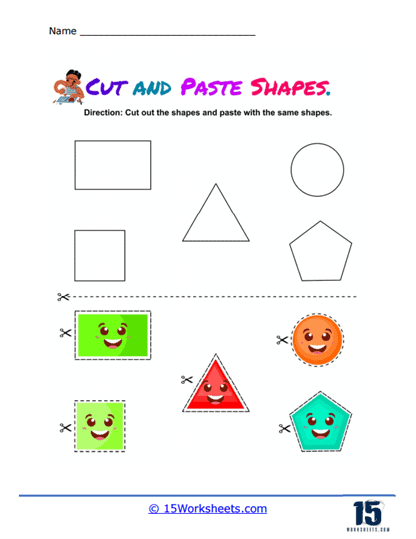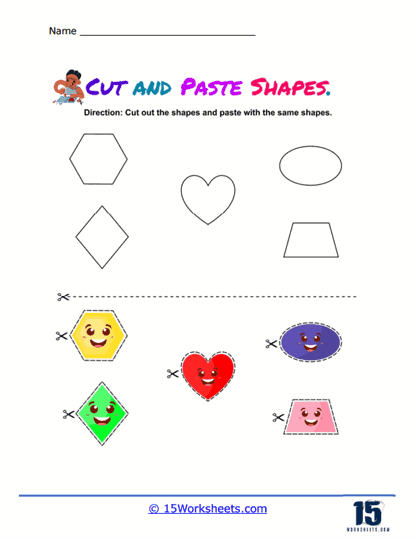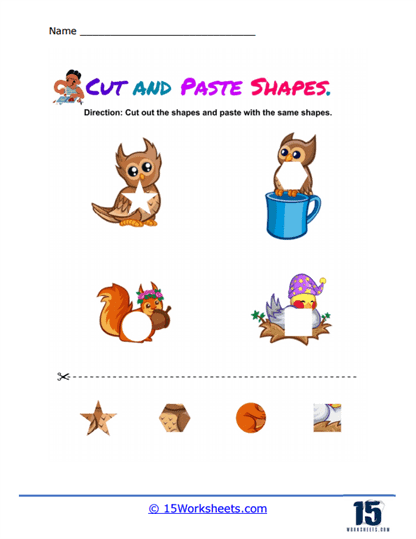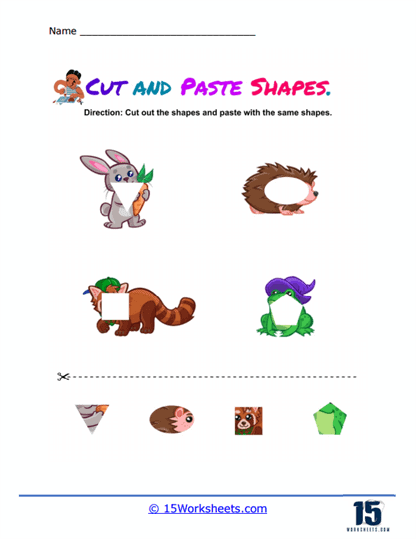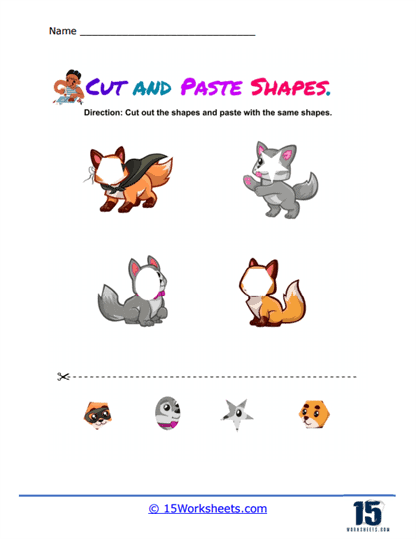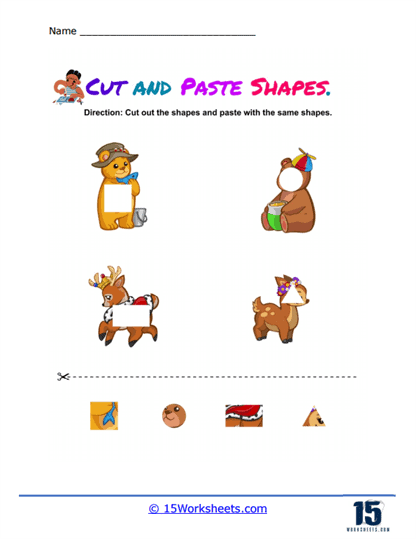Cut and Paste Shapes Worksheets
All About These 15 Worksheets
Imagine a worksheet with a bunch of different shapes printed on it – circles, squares, triangles, rectangles, and maybe even some more complex shapes like hexagons or octagons. These shapes might be all mixed up, scattered around the page.
Some worksheets might even have them in different sizes or orientations. The first part of the worksheet’s job is to help you learn to recognize these shapes no matter how they’re presented. You’ll look at them and say, “That’s a square, because it has four sides of equal length and all its angles are right angles,” or, “That’s a triangle because it has three sides and three angles.”
How Students Do Cut And Paste Worksheets
The ‘cut and paste’ part comes in when you’re asked to take scissors (safely, of course) and cut out these shapes. Cutting out shapes from a worksheet can be a bit challenging, but that’s the point! This helps develop your fine motor skills, which are the tiny muscle movements in your hands and fingers that you use to do things like write, type, and, yes, cut out shapes. Fine motor skills are super important for all kinds of everyday tasks, and worksheets like these can be a fun way to practice them.
Once you’ve cut out the shapes, you then paste them onto another part of the worksheet. Maybe there’s a specific spot for each shape, and you have to match them correctly. This could be a picture where you’re asked to complete it by pasting the correct shapes into the right spots. Or perhaps there’s a problem to solve, like arranging the shapes to form a larger shape or a pattern. This activity helps you think about how shapes can fit together and how they can be used to construct bigger shapes or designs.
At the core of the collection are shape-based identity missions. In Smiley Diamonds, Red Triangles, Squishy Ovals, Joyful Pentagons, Smiling Squares, Yellow Hexagons, Learning Rectangles, and Perfect Circles, students meet shapes with personalities. A triangle may be red, but it’s also proud. A circle might be perfect, but also a little modest. Through cheerful visuals and interactive cutting and gluing, children begin to associate names, forms, and characteristics-laying the groundwork for shape fluency without ever feeling like it’s a lesson.
Then, things get a bit trickier-in a good way. Worksheets like Tricky Stars, Happy Shapes, and A Variety of Five ask kids to sort, compare, and analyze shapes that are mixed together like a puzzle box. These tasks deepen their thinking: Is this shape truly a square, or just pretending? What makes this star so tricky, and why is it always winking? The worksheets stretch cognitive muscles in fun, low-pressure ways, asking students to apply logic without ever saying the word “logic.”
But perhaps the most delightful twist comes with the storytelling worksheets: Animal Cutouts, Bunny and a Carrot, Furry Friends, and Bears and Reindeers. Here, shapes transform into characters. A hexagon becomes a bunny ear, a rectangle becomes a reindeer’s belly, and suddenly math class feels like craft time at grandma’s kitchen table. These worksheets foster creativity and narrative thinking, giving students the sense that they’re building something bigger-stories made of shapes, scenes made of scissors.
These worksheets are more than just a fun arts and crafts project – they’re a learning tool. They can help you understand what different shapes look like and how they can be used, improve your fine motor skills, and even help with problem-solving and spatial awareness. Plus, you get the satisfaction of creating something with your own hands.
What Types of Skills Will These Printables Help?
These worksheets often include activities such as:
Cutting Practice – Children can develop their fine motor skills and scissor control by cutting out various shapes along dotted lines or outlines.
Shape Matching – After cutting out the shapes, children can be asked to match and paste them onto corresponding shapes on the worksheet, reinforcing shape recognition and spatial awareness.
Shape Sorting – Children may be asked to sort and paste the shapes into designated areas based on their properties, such as the number of sides or corners, promoting their understanding of shape properties and comparison skills.
Shape Patterns – Worksheets may require children to complete a pattern by cutting and pasting the appropriate shapes in the correct sequence, which helps them practice pattern recognition and sequencing skills.
Creating Scenes or Pictures – In some activities, children can use the cut-out shapes to create their own scenes or pictures, encouraging creativity and imagination while reinforcing shape recognition and manipulation skills.
Cut and paste shapes worksheets provide a hands-on, engaging way for young children to learn about shapes, develop fine motor skills, and build a foundation for more advanced geometric concepts. They can be used by teachers and parents to supplement the learning process and make it more enjoyable for the child.
Why Are Cut and Paste Activities Important For Kids?
Cut and paste activities are important for kids for several reasons. They help develop essential skills, foster creativity, and engage children in a fun, hands-on learning experience. Some of the key benefits of cut and paste activities for kids include:
Fine Motor Skills Development – Using scissors to cut and handling small objects to paste require precise hand movements and coordination, helping children develop their fine motor skills. These activities require children to coordinate the movements of their hands, fingers, and eyes, which helps improve their hand-eye coordination.
Bilateral Coordination – Cutting and pasting involve using both hands together in a coordinated manner, promoting bilateral coordination, which is essential for various daily activities.
Scissor Skills – Cut and paste activities provide children with opportunities to practice using scissors, which helps them develop their scissor skills and learn to cut safely and accurately.
Spatial Awareness – When children arrange cut-out pieces on a page or surface, they develop their spatial awareness, learning how different pieces fit together and how they relate to each other in space.
Creativity and Self-expression – Cut and paste activities allow children to create unique projects and designs, encouraging them to use their creativity, imagination, and self-expression.
Sequencing and Problem-solving – Cut and paste activities often involve organizing pieces in a specific order or pattern, helping children develop their sequencing and problem-solving skills.
Following Directions – Many cut and paste activities come with instructions, requiring children to follow step-by-step directions, which helps improve their listening and comprehension skills.
Confidence Building – Successfully completing a cut and paste project can boost a child’s self-confidence and sense of accomplishment, motivating them to take on new challenges.
Engaging Learning Experience – Cut and paste activities offer a hands-on, interactive learning experience that can hold children’s attention and make learning more enjoyable.
Incorporating cut and paste activities into a child’s learning routine can provide opportunities for skill development, creativity, and self-expression while offering an engaging and enjoyable learning experience.

